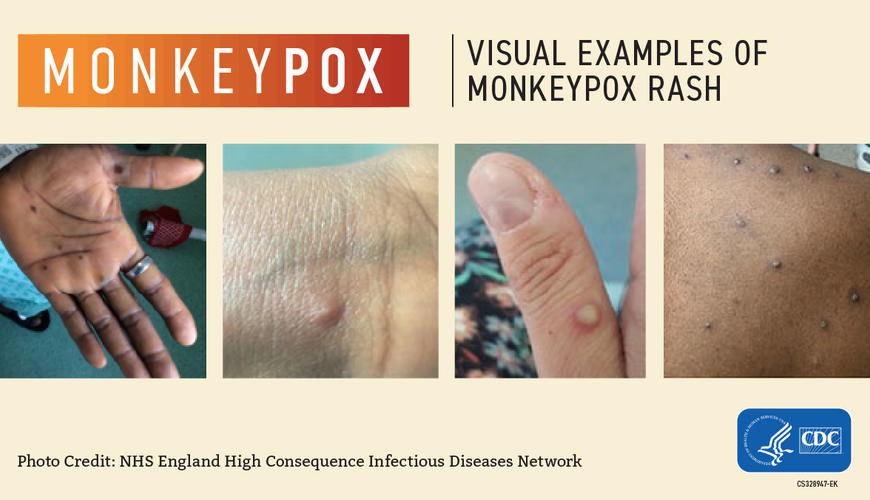
Monkeypox
Student Health Services has diagnostic testing for MPV for students. Vaccines are available but are in limited supply. SHS can assist in finding a local MPV vaccine provider. Call 910.521.6219 or send a secure portal message.
What is monkeypox?
- Monkeypox is a disease caused by a virus similar to smallpox, but symptoms from monkeypox are usually milder.
- Infections with the type of monkeypox in this outbreak are rarely fatal, as 99% of persons are likely to survive, but symptoms can be painful.
How is monkeypox spread?
Monkeypox can spread to anyone through close, personal, often skin-skin contact including:
- Direct contact with monkeypox rash, scabs, or bodily fluids from a person with monkeypox.
- Touching objects, fabrics (clothing, bedding, or towels), and surfaces that have been used by someone with monkeypox.
- Contact with respiratory secretions.
What are the symptoms of monkeypox?
Monkeypox symptoms usually start within three weeks of exposure to the virus.
- Flu-like symptoms may occur initially and could include fever, headache, muscle aches and backaches, sore throat, cough, swollen lymph nodes, chills, or exhaustion.
- The characteristic rash will usually develop a rash 1-4 days later, but a rash may develop with mild or no preceding symptoms.
- The rash may be located on or near the genitals or anus but could also be on other areas like the hands, feet, chest, or face.
- The rash will go through several stages, including scabs, before healing.
- The rash can look like pimples or blisters and may be painful or itchy.
- The rash may also be inside the body, including the mouth, vagina, or anus.
What steps can I take to prevent getting monkeypox?
- Avoid close, skin-to-skin contact with people who have a rash that looks like monkeypox.
- Do not touch the rash or scabs of a person with monkeypox.
- Do not kiss, hug, cuddle, or have sex with someone with monkeypox.
- Do not share eating utensils or cups with a person with monkeypox.
- Do not handle or touch bedding, towels, or clothing of a person with monkeypox.
- Wash your hands often with soap and water or use an alcohol-based hand sanitizer.
- In Central and West Africa, avoid contact with animals that can spread monkeypox virus, usually rodents and primates. Also, avoid sick or dead animals, as well as bedding or other materials they have touched.
- At this time, the risk of monkeypox in the United States is believed to be low. Monkeypox does not spread easily between people; however, anyone in close contact with a person with monkeypox can get it and should take steps to protect themselves. People who do not have monkeypox symptoms cannot spread the virus to others.
What should a person do if they have symptoms of monkeypox?
- Make an appointment with University Health Services by calling 910.521.6219 or see your healthcare provider to have a medical evaluation done.
- Avoid close, skin-to-skin contact with people until you have been evaluated by a healthcare provider.
- Wear a well-fitting mask when around others and keep the rash covered.
If you are diagnosed with monkeypox:
- Isolate at home until you are cleared to return to activity. This is usually until your rash has healed, all scabs have fallen off, and a fresh layer of intact skin has formed. This can take up to 2-4 weeks.
- If you have an active rash or other symptoms, stay in a separate room or area away from people or pets you live with, when possible and use a separate bathroom.
- Think about the people you have had close, personal, or sexual contact with during the last twenty-one days. To help stop the spread, you might be asked to share the information if you have received a monkeypox diagnosis.
- Avoid close contact with pets and animals during this time.
How should I clean areas if there is a concern of monkeypox?
- Perform disinfection using an EPA-registered disinfectant with an Emerging Viral Pathogens claim, which may be found on EPA's list (https://www.epa.gov/pesticide-registration/disinfectants-emerging-viral-pathogens-evps-list-q). Follow the manufacturer's directions for concentration, contact time, and care and handling.
- Focus on disinfecting items and surfaces that were in direct contact with the skin of the person with monkeypox, or often in the presence of the person with monkeypox, during isolation. Do not dry dust or sweep as this may spread infectious particles.
- Linens can be laundered using regular detergent and warm water. Soiled laundry should be gently and promptly contained in a laundry bag and never been shaken or handled in a manner that may disperse infectious material. It should not be mixed with laundry from other members of the household without monkeypox.
- Any soiled items should not be directly handled without proper protective equipment including mask and gloves. Clothing should be worn that fully covers the skin and should be washed immediately after cleaning.
- Anyone who touches lesions or clothing, linens, or surfaces that may have had contact with lesions should wash their hands immediately to prevent potential spread.
Resources
https://www.cdc.gov/poxvirus/monkeypox/index.html
https://www.cdc.gov/poxvirus/monkeypox/faq.html
https://www.cdc.gov/poxvirus/monkeypox/specific-settings/congregate.html